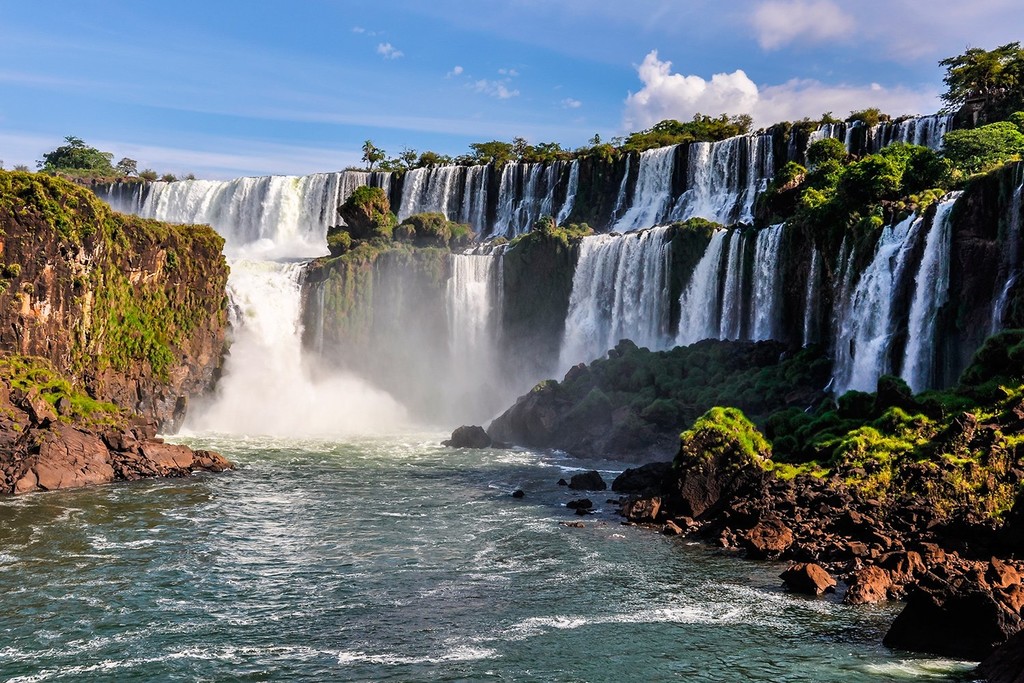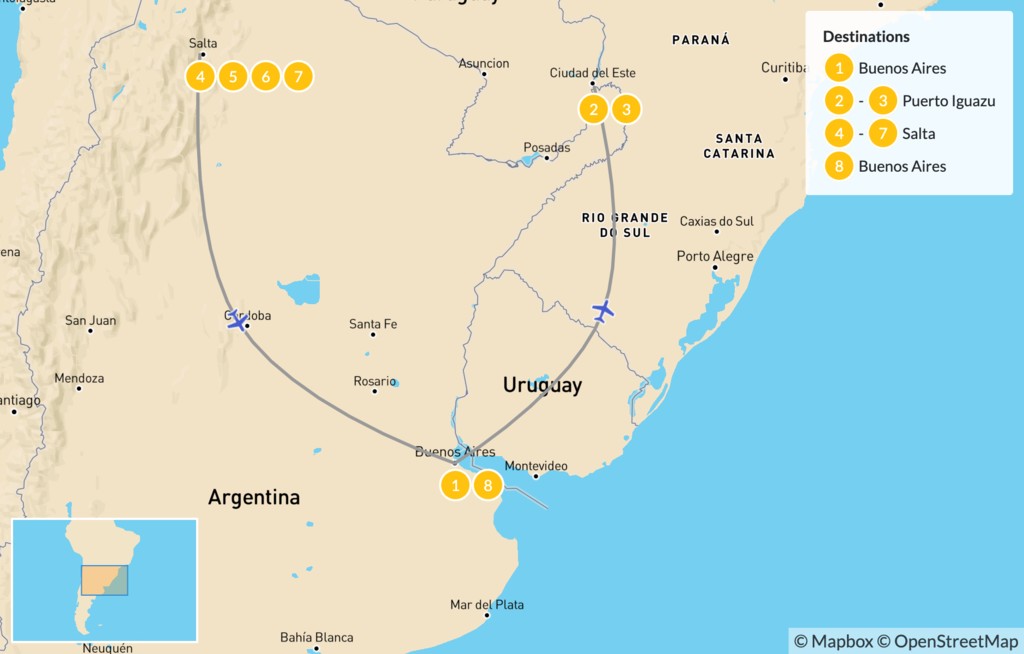
Discover Northern Argentina - 9 Days

Highlights
- Check out the best sights and neighborhoods in Buenos Aires
- Explore several areas of Iguazú Falls, one of the largest waterfalls in the world
- Ride Salta's scenic gondola and check out its folkloric music scene
- Discover Salinas Grandes, the expansive salt flats north of Salta
- Visit wineries near Cafayate and enjoy tasting tours
Brief Itinerary
| Day | Highlights | Overnight |
|---|---|---|
| Day 1 | Explore Buenos Aires | Buenos Aires |
| Day 2 | Fly from Buenos Aires to Puerto Iguazú | Puerto Iguazu |
| Day 3 | Explore Iguazú Falls (Argentine Side) | Puerto Iguazu |
| Day 4 | Fly from Iguazú to Salta | Salta |
| Day 5 | Cafayate Tour & Wine Tasting | Salta |
| Day 6 | Jujuy Province & Salinas Grandes Excursion | Salta |
| Day 7 | Quebrada de Humahuaca Excursion | Salta |
| Day 8 | Fly from Salta to Buenos Aires | Buenos Aires |
| Day 9 | Depart Buenos Aires |
Detailed Itinerary
Day 1: Explore Buenos Aires

Welcome to Argentina! Renowned as the "Paris of South America" and the "Queen of El Plata", the capital city of Buenos Aires is famous for its passion. This can be seen in Argentina's rich tango heritage and its citizens' limitless enthusiasm for fútbol (soccer), the country's most popular sport.
When you arrive at the airport, your driver will take you to your hotel where you will have the chance to recharge from the journey. Once you are well-rested, be sure to venture out into the welcoming arms of Buenos Aires and explore. The city center is your best starting point.
Day 2: Fly from Buenos Aires to Puerto Iguazú

After breakfast, you'll transfer to the airport in Buenos Aires for your flight to Puerto Iguazú. This city is home to the Argentinian side of Iguazú falls, the world's second-largest waterfall system after Victoria Falls, in Africa. Upon arrival in Puerto Iguazú, you will transfer to your hotel.
You will have the rest of the day free to relax. Should you choose, you can visit the Three Borders Landmark in the tri-border area between Argentina, Brazil, and Paraguay. The landmark is situated at the confluence of the Iguazú and Parana rivers and there are three obelisks representing the three countries that meet here.
Day 3: Explore Iguazú Falls (Argentine Side)

After breakfast at your hotel, a driver will pick you up and drop you off at the entrance of Iguazú National Park, the Argentine side of the falls. This is where you will begin the day's adventure, a full-day tour that involves walking the three circuits that weave around the falls. Each of these offers different vantage points from which to view the water.
At the end of the tour, the driver will pick you up and take you back to your hotel.
Chat with a local specialist who can help organize your trip.
Day 4: Fly from Iguazú to Salta

After breakfast, you'll be driven to the airport for your flight to Salta where you'll then take a private transfer to your hotel. The city is often referred to as "Salta la Linda" (meaning Salta the beautiful) due to its well-preserved colonial architecture (circa 16th century) and year-round warm climate. In the afternoon you'll take a guided city tour and visit Salta's most important buildings and cathedrals.
Afterward, you will have free time to stroll around the craft market and pick up artisanal products that range from rugs to pottery. In the evening, enjoy a traditional Argentinian dinner at a cozy local restaurant.
Day 5: Cafayate Tour & Wine Tasting

Today you'll be visiting the village of Cafayate, located in the middle of the Calchaquí Valley. The optimum growing conditions here rival Mendoza so you're in for some scenic vistas with mountain landscapes and impressive rock formations. Upon arrival you will visit one of the area's famed wineries and, of course, indulge in a tasting.
The excursion begins with a pick up at your hotel and a drive through the Lerma Valley, passing tobacco fields and colonial villages. You'll then enter the Quebrada del Río de las Conchas, where you'll see curious rock formations (the result of erosion caused over time by wind and water). There are many noteworthy sights here, with names as unique as the formations: the dunes, the toad, the bishop, the devil's throat, castles, and amphitheater, among others.
Then, continue along the National Route 68, arriving in the village of Cafayate, which is internationally recognized for its wine production. The most popular varietal grown here is Torrontés, which you'll get a chance to taste when you visit a regional winery. At the end of the day you'll return to Salta by the same route which you arrived; however, with the sun lower in the sky, the high-altitude landscapes will be all the more evocative.
Day 6: Jujuy Province & Salinas Grandes Excursion

It's time for another tour of the Salta region. Like yesterday, you'll be picked up from your hotel in the early morning for a full-day tour.
First, you'll visit the ruins of Tastil, once home to the Atacama indigenous people. Next stop is the nearby town of San Antonio de Los Cobres, where you'll stop for lunch. Afterward, it's a scenic trip along Argentina's famous Ruta 40 to Salinas Grandes, the expansive salt flats. You'll have plenty of time to snap photos of the beautiful vastness of the salinas, which are particularly evocative due to the sunlight reflecting off the ground's white surface back into the bright blue sky.
Afterward, it will be time for the descent down Cuesta de Lipán, a section of switchback roads on a steep mountain that features amazing viewpoints—where you might get lucky and spot condors. Then you'll travel to the village of Purmamarca, located in Jujuy province. Here you'll visit its famous Cerro de los Siete Colores (Hill of the Seven Colors), a hilly landscape overlooking the town that's colored various shades of red.
Day 7: Quebrada de Humahuaca Excursion

There are few more mystic, historic, and evocative areas in Argentina than the Quebrada de Humahuaca. This arid desert valley gets its start in the high altitude Andean plateaus before running down into Jujuy Province and meeting the Río Grande, at which point it forms a 96-mile (155-km) corridor.
This valley gorge has been populated by humans for over 10,000 years, starting with the earliest hunter-gatherers. It then became an important Incan trading route in the 15th and 16th centuries and later was a link between the Viceroyalty of the Río de La Plata, in Buenos Aires, and the Viceroyalty of Peru. It was also an important battleground in the War of Independence. You can see remnants of Pre-Hispanic towns here, and small white churches still dot the gorge's stratified rocks.
Your tour of the area begins with an early morning pickup at your hotel in Salta. The first place you'll visit is the village of Purmamarca, where you'll find the famous Cerro de Siete Colores (Hill of the Seven Colors), which is notable for its strata, which is seemingly "painted" various shades of red. Other notable sites in the village include the whitewashed Iglesia de Santa Rosa, and the artisanal craft market.
Then head a few miles north to the town of Tilcara and Pucará de Tilcara, the hilltop remains of a pre-historic fortress where you'll visit a fascinating archeological museum. From here you'll visit Uquía, a tiny village that boasts one of the most impressive whitewashed churches in the region, the Iglesia San Francisco de Paula, which was built in 1691. Inside the church, you'll find a number of paintings done in the Cuzco style and featuring angels in 17th-century battle dress.
Before lunch, you'll arrive at the town of Humahuaca, which is denoted by its labyrinthine narrow streets, adobe houses, and its monument to independence, El Indio, done by sculptor Soto Avendaño.
After lunch, your tour will continue to the town of Maimará, notable for its haunting hillside cemetery and the brightly colored mountains that surround it. These are known as La Paleta del Pintor (The Painter's Palette). If time allows, we will return to Salta via the Abra de Santa Laura (a mountain path lined with subtropical vegetation), which is surrounded by stunning scenery, including Las Maderas Dam, and Campo Alegre reservoir.
Day 8: Fly from Salta to Buenos Aires

After breakfast, it's time to say goodbye to the city of Salta and transfer to the airport for your domestic flight to Buenos Aires. Upon arrival, you'll take a private transfer to your hotel. Once settled, enjoy free time to relax and explore at your own pace, perhaps taking advantage of any sights, parks, or neighborhoods that you may have missed earlier in your trip.
Day 9: Depart Buenos Aires

Enjoy one last breakfast in Buenos Aires. When it's time to leave, a driver will pick you up at your hotel and take you to the airport for your flight home. Buen viaje!
